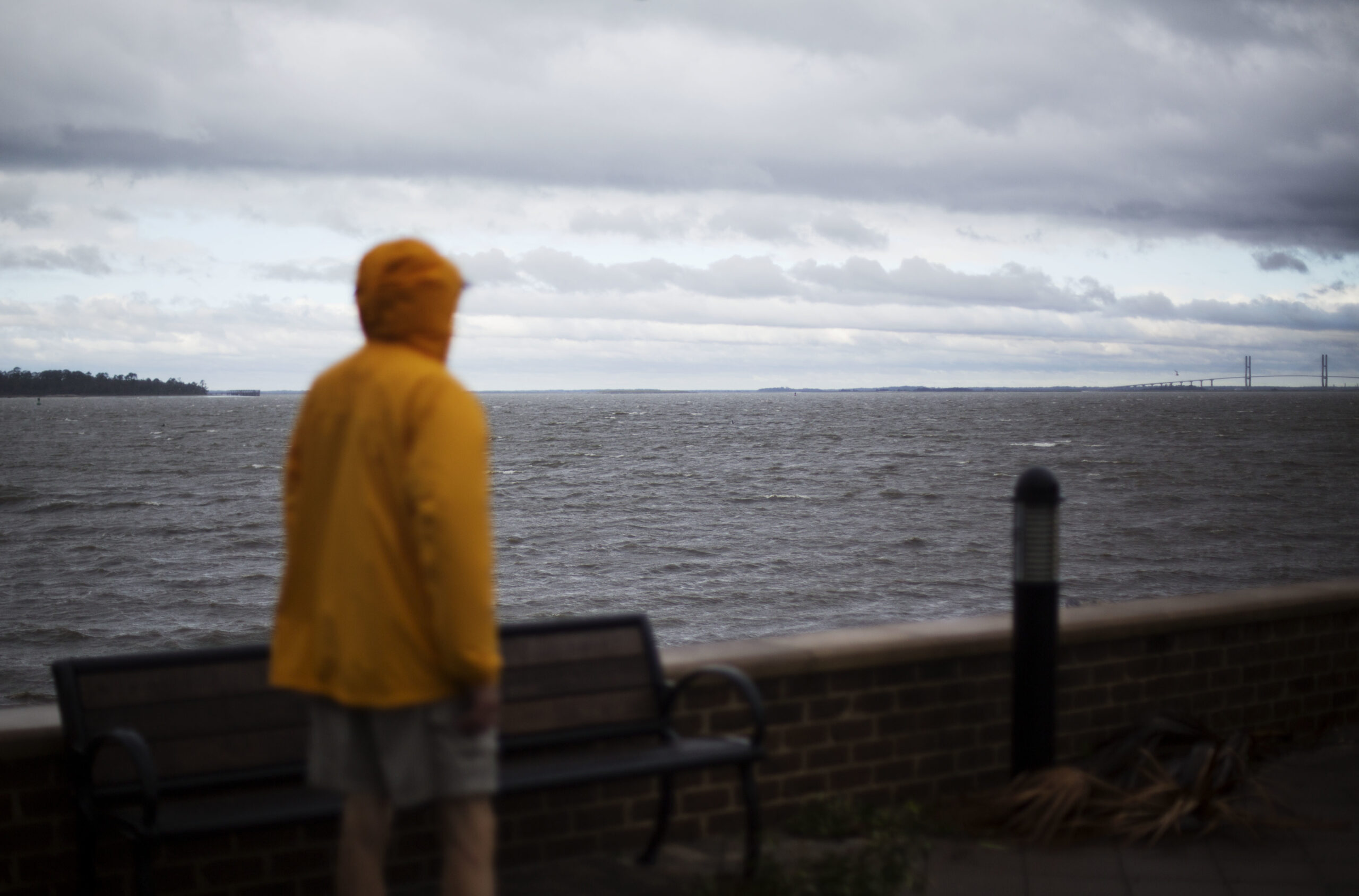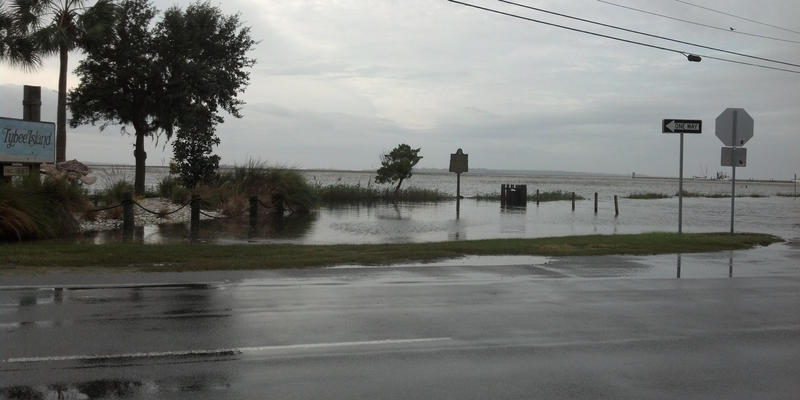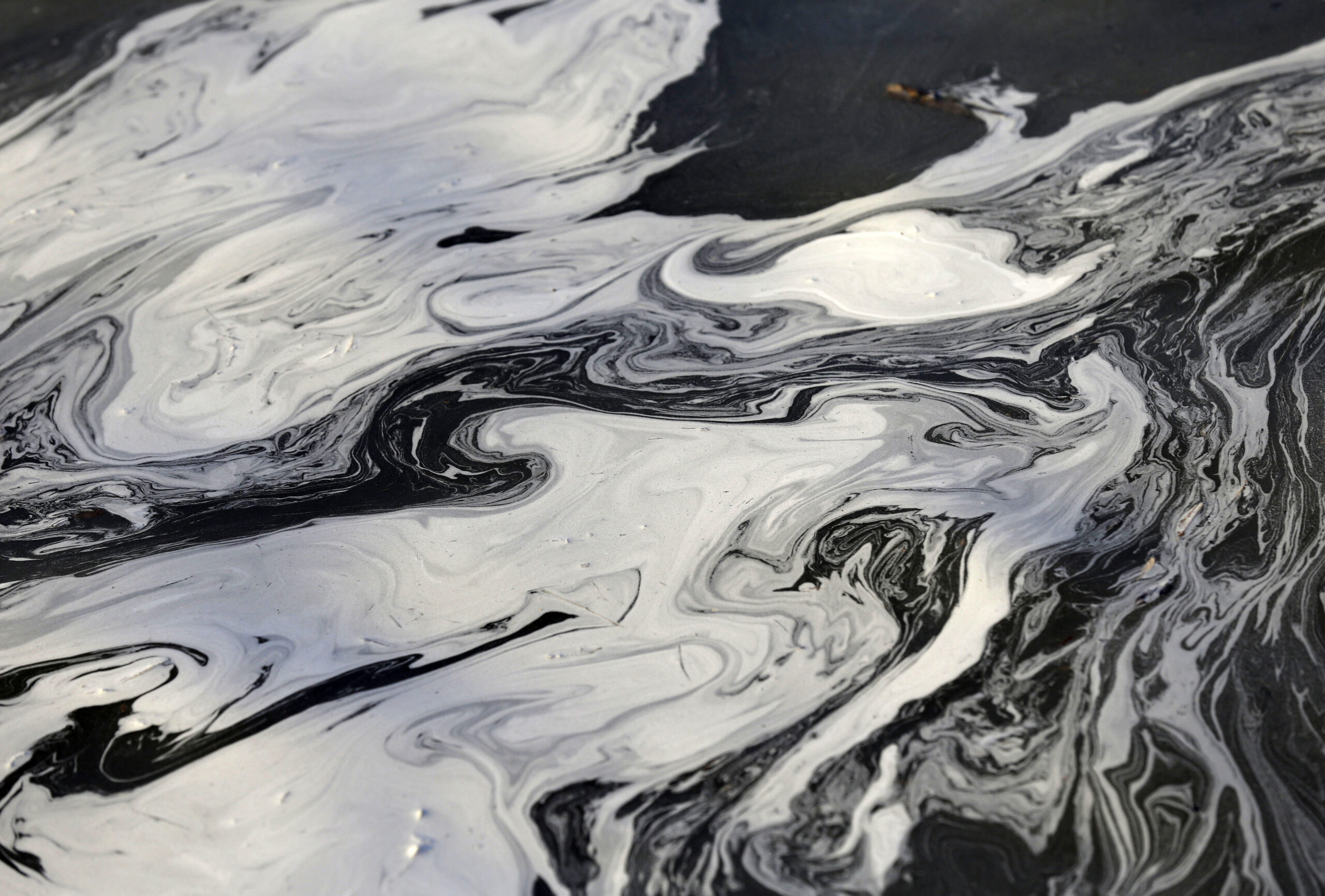Hurricane Season Close To An End, But Georgia’s Coast Struggles With Persistent Flood Threats

In 2016, resident Ron Wilson looks out to sea after Hurricane Matthew passed through St. Simons Island. While storms like Matthew can make an impact, there is another looming threat to the area: sea-level rise inching up the Georgia coast, a slow-motion inundation that doesn’t recede.
David Goldman / Associated Press file
Hurricanes Matthew and Irma were wake-up calls to many on the Georgia coast. The 2016 and 2017 storms – less than 12 months apart – swamped coastal communities, leaving homes that had never previously flooded a mess.
Some flooded twice.
For years, Georgia had missed such damaging direct hits from hurricanes. The pair of storms spurred planning, as local officials grasped the danger of future catastrophic storms. (Hurricane Michael, in 2018, did more damage to southwest Georgia farmers than to the coast.)
Even so, as another hurricane season comes to a close, officials in Coastal Georgia are struggling to enact solutions to adapt to rising seas and catastrophic weather.
“You look at two significant weather events like Matthew and Irma, all of a sudden, it becomes very real,” said Glynn County Commissioner Bill Brunson, whose home flooded with about an inch of water during Irma. “It’ll get your attention.”
At the same time, the storms jolted some into grappling with another looming threat: the sea-level rise inching up the Georgia coast, a slow-motion inundation that doesn’t recede.
But unlike a hurricane, sea level rise is hard to see. Even with plans in place, it can be tough to enact safety measures. Infrastructure adaptations are expensive. Political interest can be intermittent. Government reports are hard for the public to rally around.
The sea level has been rising about a foot a century on the Georgia coast. In the last 80 years, it’s come up several inches. Scientists say the rise will likely speed up; sea levels could gain another 3 feet or more by 2100.
Scientists say the rise is caused by greenhouse gas emissions, which heat the atmosphere and drive up water levels in two ways: one, by melting glaciers and ice caps, so that there’s more water in the oceans; two, by warming the oceans themselves, because warmer water takes up more space than cooler water.
That threatens homes, schools and businesses in Georgia, sewer and water infrastructure, roads and highways.
Getting beyond ‘a Band-Aid here and a Band-Aid there’
In September, the Glynn County Commission officially adopted its most recent report on coastal flooding. The Shoreline Assessment and Implementation Resiliency Plan lays out nearly 70 hot spots at risk in the city of Brunswick, Jekyll Island and unincorporated Glynn County, which includes St. Simons.
Downtown Brunswick, Highway 17 in multiple locations, a wastewater treatment plant on the mainland. Marshfront homes, the King and Prince Hotel and Fort Frederica on St. Simons Island. Another wastewater treatment plant, roads and a cemetery on Jekyll.
The report, funded by a grant to Georgia’s Department of Natural Resources from the National Oceanic and Atmospheric Administration, also recommends solutions for each location and suggests places to find funding.
It’s essentially a roadmap for Glynn County, listing what needs to be done, how it should be done, and who might help pay for it.
“What excites me most about this project is it’s a more strategic approach than putting a Band-Aid here and a Band-Aid there, and not really understanding our priority levels,” said Kathryn Downs, assistant manager of Glynn County. “So as we think about funding opportunities in the future, we have a more strategic approach to dealing with these issues in our community.”

The report doesn’t put a price tag on the proposed solutions. But the costs to achieve it all would be staggering. Downs said the planning department has a grants writer on the lookout for opportunities. But money, staffing and political will are all potential hurdles to keep this work going, said Ashby Nix Worley, coastal climate adaptation director for The Nature Conservancy in Georgia.
“Now I think it’s up to the communities to start putting these projects on the ground, as well as partners kind of encouraging and working alongside them to see it happen,” she said.
Funding could be the hardest to deal with. Brunson said changing policies is relatively simple, compared to finding the money for the recommended infrastructure work.
“Creating ordinances to elevate housing and control where the freeboard is, those are easy,” he said. “You just don’t build a dadgum house on a slab on the ocean.”
But paying to elevate highways or a wastewater treatment plant is a whole other level, he said. “Just wonder how in the world you’re going to figure out how you’re ever going to accomplish some of those things.”
Brunson said he’s hoping a possible special election in March would fund some of that work, with a special purpose local option sales tax. Some of the suggested projects in the plan could be among those included for funding.
But, he said even if that happens, the county would still need help from the state and the federal government to pay for all that’s needed.
“It’s just too big for a local government to deal with,” Brunson said.
Earlier plans still not complete
Upgrades and adaptations for sewer and water infrastructure alone could be hundreds of millions of dollars.
“You got 30,000 customers, there’s no way you’re going to raise rates enough to get that kind of cash flow,” said Andrew Burroughs, executive director of the Brunswick-Glynn County Joint Water & Sewer Commission.
A 2017 report on climate adaptation and resilience for the utility recommended dozens of solutions for the system, including waterproofing electrical components and using saltwater-resistant equipment.
“If you looked at the climate plan as, we need to check projects one through 10 off the list, we probably aren’t going to check many of those boxes,” Burroughs said. “But we have done projects that will help in these situations.”
He said the utility is working to seal older pipes so that less water leaks into them, and it’s raised some of its drinking water wells so they won’t be inundated by floods.
They’ve also learned from Matthew and Irma, he said, working on ways to get service back to people faster, to collaborate more closely with other agencies and utilities and to improve communication around boil water advisories.
‘It’s not real to people’
Frances Zwenig, a St. Simons resident and local activist, said the plans aren’t enough for her.
“My eyes gloss over,” she said.
What she really wants, she said, is to see more leadership and action. She organized a symposium on sea level rise for the Coastal Georgia Foundation in 2019. And she said she’s frustrated not to have seen more response since then.
“It’s not real to people,” she said.
Disasters – like the pair of hurricanes – do help remind people of the urgency, said Jennifer Kline, coastal hazard specialist with Georgia’s Coastal Resources Division.
She works with state and federal agencies and local communities on coastal science and policy. And she said it’s part of her job to keep the pressure on local officials, “to remind them, this is still an issue, we still need to plan for it. And to keep pressing ahead.”
And she emphasized the role of community members in that, too.
“It’s really your job to hold our leaders accountable for having that information, and using the information that they have,” Kline said.
The coronavirus makes it harder.
“If there were any momentum, everything is wiped out because of the pandemic,” Zwenig said. “I mean, even me, I’m staying in my house. I don’t want to get it.”
She said the pandemic also demonstrates that even presenting people with science – whether it’s about how masks can reduce transmission of the virus, or about how greenhouse gas emissions are leading to higher seas – doesn’t mean they’ll be willing to do the right thing with the information.
“If people can’t even be motivated to put a mask on to protect themselves and be considerate of other people, how in the world are we going to convince them to take steps that are going to be economically challenging on rising sea levels?” she said. “It’s quite depressing when you think about it.”
Glynn County is now working on an additional piece of its resiliency plans, with a report focused on short- and long-term strategies to prepare for more sea level rise. That study is expected to be done next March.
This story was reported in partnership with The Current, a nonprofit coastal Georgia news site.







